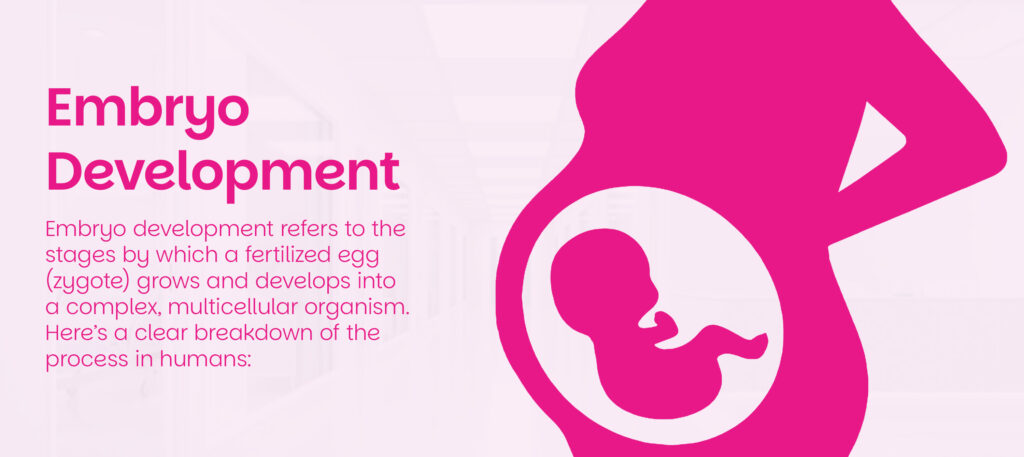Embryo development is the foundation of human life. From the moment an egg is fertilized by a sperm, a complex and beautifully orchestrated process begins. Whether you’re a medical student, expectant parent, or someone exploring fertility treatments like IVF, understanding embryo development provides deep insight into the miracle of life. In this guide, we’ll walk through every essential phase of embryonic growth—from zygote formation to organ development—with clarity and detail.
What Is Embryo Development?
Embryo development refers to the stages a fertilized egg (zygote) undergoes to become a fetus. This process is typically divided into three main phases:
- Germinal stage (0–2 weeks)
- Embryonic stage (3–8 weeks)
- Fetal stage (begins after week 8, not covered in detail here)
Each stage plays a critical role in shaping the biological structure of a new human life.
The Germinal Stage (Fertilization to Day 14)
Fertilization and Zygote Formation
- Life begins when sperm penetrates the egg, creating a zygote with 46 chromosomes—23 from each parent.
- This single-cell zygote contains all the genetic instructions needed to form a human.
Cleavage and Morula Formation
- Within 24 hours, the zygote begins dividing through a process called cleavage.
- By Day 3, it becomes a morula—a compact cluster of 16 cells.
Blastocyst Formation and Implantation
- By Day 5, the morula transforms into a blastocyst, a hollow ball of cells with a fluid-filled cavity.
- The outer layer, called the trophoblast, will form the placenta.
- The inner group, the embryoblast, becomes the embryo.
- Around Day 6–10, the blastocyst implants into the uterine lining, beginning pregnancy officially.
The Embryonic Stage (Week 3 to Week 8)
Gastrulation – Formation of Germ Layers
- Around Day 15, the embryoblast reorganizes into three germ layers:
- Ectoderm: Forms the brain, spinal cord, and skin
- Mesoderm: Develops into muscles, bones, heart, and kidneys
- Endoderm: Creates the digestive system, liver, and lungs
Neural Tube and Organ Formation
- By Week 4, the neural tube forms, which becomes the central nervous system.
- Heart cells start to beat, and basic circulation begins.
Limb Buds, Eyes, and Facial Features
- Weeks 5–7: The embryo develops arm and leg buds, eyes, and facial contours.
- Organs like the liver, lungs, and stomach begin forming.
Week 8 – Transition to Fetal Stage
- The embryo now measures about 1.6 cm.
- Almost all major organs and structures are present, though not fully developed.
- From Week 9 onward, the embryo is now called a fetus.
Embryo Development and IVF Success
Understanding embryo development is critical in IVF (In Vitro Fertilization). The healthier the embryo, the higher the success rate of implantation and pregnancy.
Embryo Grading in IVF Labs
- Embryologists evaluate embryos based on cell count, symmetry, and fragmentation.
- Ideal embryos at Day 3 have 6–8 uniform cells.
- Day 5 blastocysts are assessed for quality of both the inner cell mass and trophectoderm.
Selecting the Best Embryo for Transfer
- Top IVF centres use advanced tools like time-lapse imaging to monitor cell division.
- This ensures only the most viable embryos are chosen for implantation.
If you are searching for a reliable and experienced fertility team, Vrinda Fertility Centre in Delhi offers personalized care and proven success in embryo culture and transfer. Stay informed through their social platforms on Facebook and Instagram.
Tips for Supporting Healthy Embryo Development
- Maintain a healthy lifestyle (avoid alcohol, smoking, and stress)
- Ensure optimal nutrition (folic acid, zinc, iron, omega-3)
- Choose an IVF centre with expert embryologists and advanced lab facilities
- Ask about embryo grading and blastocyst transfer for better outcomes
- Consider genetic screening to enhance implantation success
Frequently Asked Questions (FAQ)
A zygote is the first single-cell stage. A morula is a 16-cell solid ball. A blastocyst is a hollow structure ready for implantation.
From fertilization to implantation usually takes about 6–10 days.
Yes. Embryo health is influenced by egg/sperm quality, lab conditions, and lifestyle choices. High-quality IVF centres use strict protocols to support healthy development.
Common reasons include chromosomal abnormalities, lab conditions, or improper cell division
Embryo grading helps doctors choose embryos with the highest chance of implantation and pregnancy.



